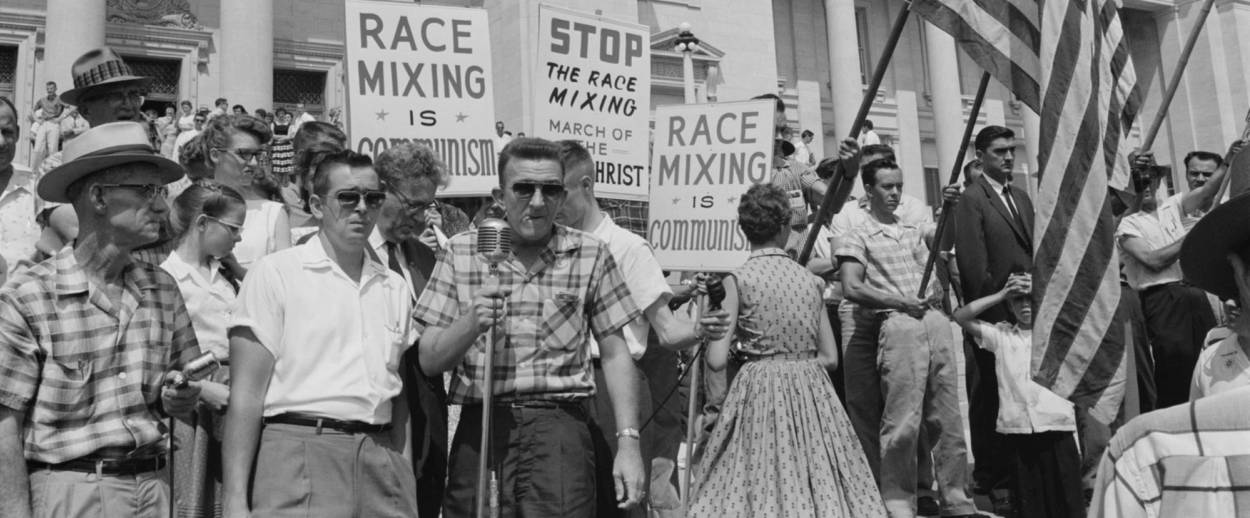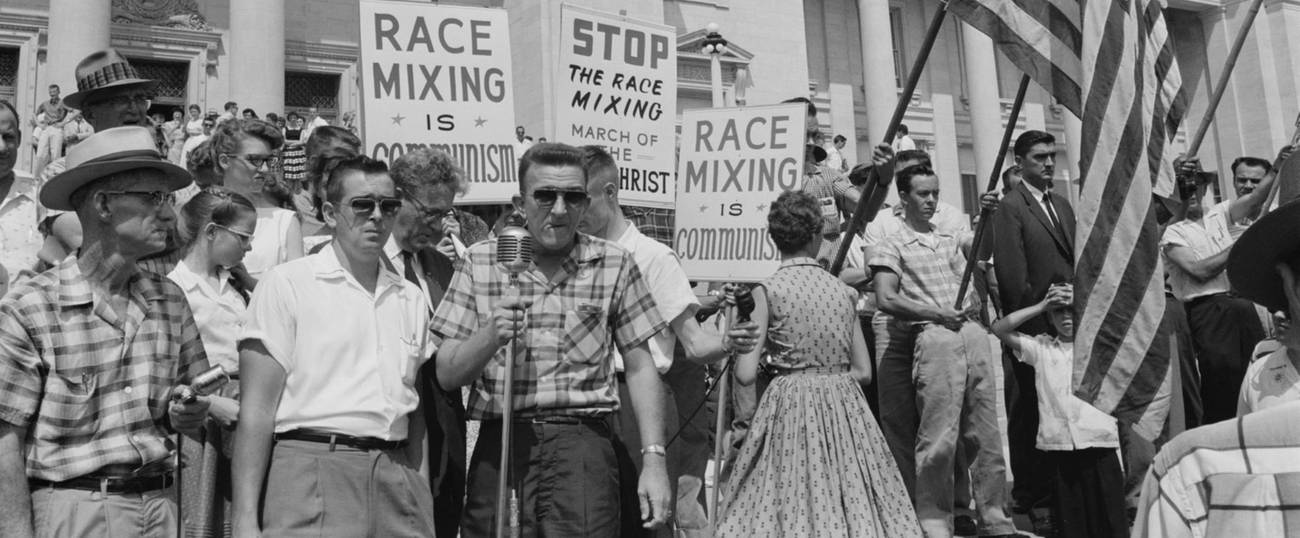Tikkun Olam, Y’all
Rabbi Ira Sanders of Arkansas, little-known Civil Rights hero




“I’ve been sold a bill of goods. I’m going home.” So said Rabbi Ira Sanders, 32, shortly after moving to Arkansas with his wife and baby daughter in 1926. The perpetual broiling sun, and vast wilderness he eyed from his hotel room had begun to inspire buyer’s remorse. Sanders had just cast off a dream position as associate rabbi for Temple Israel in New York, one of the most high-profile synagogues in the country. Feeling unmoored in the city of 6 million and craving the opportunity to make a more palpable impact on people’s lives, Sanders had been skillfully wooed by Congregation B’nai Israel of Little Rock.
Lucky for those Reform congregants, Sanders ultimately warmed to the Southern city and served as their rabbi for nearly 40 years. An important new biography by James L. Moses, Just and Righteous Causes: Rabbi Ira Sanders and the Fight for Social Justice in Arkansas, meticulously chronicles Sanders’ significant, if largely till now unheralded, role in Southern Jewish history. Moses is a latter-day congregant of B’nai Israel of Little Rock and a professor of history at Arkansas Tech University. His book offers an insider’s perspective of Sanders’ life, drawing on conversations with his daughter, Flora, as well as with others who remembered him in the community. “I’d often heard my fellow congregants talk about Sanders in these very laudatory, almost eulogistic terms, about what a great guy he was, what an important figure he was in the community. So I started digging into the temple archives about his professional life,” Moses said of the book’s origins.
As Moses’ colorful historical prose attests, Sanders, who studied and trained in social work, helped found several social services agencies, including Little Rock’s first birth control clinic with Margaret Sanger. (Uncharacteristically, he did briefly dabble in eugenics.) He fought for good paying jobs and Depression-era relief funds for African-Americans, helped desegregate the Little Rock Library, and made other, sometimes perilous, pleas for civil rights. The latter efforts culminated in a life-threatening speech before the Arkansas General Assembly in 1957, which was poised to vote on legislation designed to circumvent desegregation orders handed down in the landmark Brown v. Board of Education Supreme Court decision. The sole Jew to speak before the heated crowd of 900 people, Sanders was immediately rushed from the scene afterward for fear he would be assassinated. His impassioned words were nevertheless unable to prevent passage of the bills, nor the violent opposition to the desegregation of Little Rock Central High School in his community.
Sanders may ultimately have failed in those high-profile endeavors but that should not detract from the fact that he quietly and shrewdly succeeded in many other ways. “He had these covers, this ecumenicalism that he enjoyed, that other Southern rabbis did not enjoy,” Moses says. “He had Catholic and Protestant clergy all working with him, so it was difficult to single out ‘the Jews’ when the Catholic bishop and the Methodist minister were alongside him.” Those strategic alliances, which Sanders forged gradually as he put down roots in Little Rock, were key to his daily tasks of his fight for civil rights. Moses says they helped inoculate Sanders from anti-Semitism. “I think people in Little Rock were certainly aware he was Jewish but they tended to see him more as one of the city’s fathers, a mover and shaker in the community.”
As Just and Righteous Causes lays bare, Sanders’ sense of righteous indignation did not first bubble up during the Civil Rights Movement. Within weeks of arriving in Little Rock in the mid-1920s, the rabbi was already agitating for racial equality when he deliberately sat in the “colored” seating area in the rear of a trolley. The alarmed conductor rushed to confront Sanders: “You know, here in the South the niggers and the whites do not sit together. Will you kindly move upfront?” The situation escalated into a shouting match, with Sanders, red-faced and seething; yet he ultimately complied. That evening, he scrapped his prepared sermon for Shabbos and instead prepared a new one that scathingly denounced Jim Crow laws. It said in part, “Any law that robs the individual of dignity and freedom could not stand.” As historian Clive Webb put it in Fight Against Fear: Southern Jews and Black Civil Rights, in the 20 years that preceded Brown v. Board in 1954, “no Southern rabbi had campaigned more rigorously against segregation than Ira Sanders of Little Rock.”
With his idealistic bent, Sanders was lucky that his congregants and synagogue’s board of trustees supported his public efforts. Other temples across the South were much more fearful of blowback retribution from segregationists. This was in part because Arkansas at the time possessed a comparatively more moderate racial climate, says Mark Bauman, editor of the journal Southern Jewish History and To Stand Aside or Stand Alone: Southern Reform Rabbis and the Civil Rights Movement.
“You did have people within the community recognizing the need for gradual, peaceful integration and this was the environment in which Ira Sanders worked.” Bauman points out that many of the small Southern Jewish communities, even in cities like Atlanta, Memphis, or Montgomery, experienced a tremendous amount of anti-Semitism, including receiving death threats and having their synagogues, community centers, and rabbis’ homes bombed for any overt support of integration.
He says their livelihoods also played a hand in the apprehension Southern Jews had of publicly speaking out. “The Jews for the most part in these cities and towns were merchants. They had department stores downtown. So they were highly susceptible to boycott—not only from whites who were segregationists but blacks who would be angry if they didn’t integrate their businesses. So these Jewish businesspeople were between a rock and a hard place.”
In recent years, historians have cast a cold, hard look at the now-mythic relationship between blacks and Jews during the tumultuous Civil Rights era. To put it mildly, it’s complicated. Southern Jews were necessarily much more fearful of reprisal for showing support than their Northern counterparts. Within that essential distinction, Bauman says Moses’ book adds much-needed gradations to the historiography by showing the contrast between the very public efforts of Sanders and the other Southern rabbis, many of whom worked behind the scenes to effect change.
For this reason, Moses says, “Southern Jews are secondary, maybe even tertiary players here. Southern rabbis played a small role. I think it’s an important role, but small in the overall picture. They tended to be more concerned with protecting their congregations.”
As his book points out, a 1958 study by the UAHC Commission on Social Action found that almost all Southern Reform rabbis supported civil rights, though to widely varying degrees of intensity and visibility. A survey conducted two years later found that while 97 percent of Northern Jews supported the Brown desegregation decision, a full 40 percent of Southern Jews called it “unfortunate.” They felt the pace of integration was simply too quick. So while Moses says the kinship between blacks and Southern Jews was real, it was also fraught. “I think Sanders had wished there had been a more outward commitment on the part of Little Rock.”
Such reticence was revelatory for the young Northern Jews who made their way to the South to fight for civil rights, says Debra Schultz, a feminist historian and author of Going South: Jewish Women in the Civil Rights Movement, in which she interviewed 15 Jewish women from the North about their experiences in the movement. Schultz says many of her interviewees were of the transitional generation of women that lacked clear career paths after college. It simply wasn’t discussed. To fill that void they instead sought out the opportunity to make a meaningful contribution by aligning themselves with racial equality and desegregation.
“For some of the women I spoke with, it was eye-opening to see that Southern Jewish communities were often really vulnerable and isolated. They realized they had to have a little more compassion for how different it was, than say, growing up in Brooklyn, where so many of the people are Jewish, versus, for example, Clarksdale, Mississippi.” Ultimately, Schultz says many of them were drawn to the South because “They identified with African-Americans and the African-American struggle.”
For Sanders, who knew at age 9 that he wanted to be a rabbi, the sense of kinship was a powerful drive. In early journal notes, he wrote that the primary realization he took from his early studies at Hebrew Union College was “Judaism’s role in the moral drama of mankind.” It is this call to service, Moses writes, that “would be the governing concept of Ira Sanders’ life in the rabbinate.” Fittingly, in advance of Sanders’ retirement in 1963, the Arkansas Gazette said, “long before most of us understood even the full meaning of the terms such as social justice and human dignity, Rabbi Sanders had begun to translate those ideas into action.”
Karen Iris Tucker is a freelance journalist who writes primarily about health, genetics and cultural politics. Find her work at kareniristucker.com and follow her on Twitter at @kareniristucker.